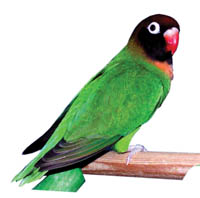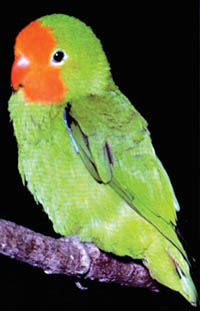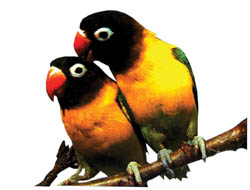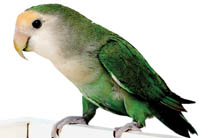|
observer |
|
|
|
|
|
OTHER LINKS |

|

|

|
|
|
|
|
Native to Africa and Madagascar Island, lovebirds are smaller members of the large parrot family. The nine recognised species of lovebirds belong to the genus (order) of Agapornis, which in Greek means Agapa (love) and ornis (bird). Why these birds, which are popular exotic pets, have been given this name is evident when you observe their affectionate behaviour towards each other and their owners.
|
|
Lovebirds are not talking parrots, but they are considered to be curious, intelligent and comical birds with expressive personalities and loving behaviour. They are very energetic and active and their antics have led them to be known as the 'natural clowns' in the parrot family.
The small beauties weighing around 8-10 grams and around 5-6 inches in length are generally sociable birds and are happier when kept in pairs or more, in captivity.
|
|
Though somewhat difficult to train as pets when acquired as larger birds, hand-fed baby birds become very tame, and make excellent pets. Three species that are popular as pets are the Peach-faced Lovebird, the Masked-face Lovebird and the Fisher's Lovebird. The other six species are the Abyssinian, Black-cheeked, Red-faced, Nyasa, Black-collared and the Madagascar (which as the name indicates, is the only species from Madagascar Island.)
|
|
The most common of these is the Peach-faced Lovebird which has a beautiful peach coloured face, light green wings and body, black flight feathers, and cobalt blue upper tail coverts and rump area. It is the most aggressive of the species and is very territorial. A single bird will make an excellent pet, though a mate is most welcome.
The colour mutations of these birds are varied and includes yellow,white, blue, cinnamon red and pied feather colouration.
Another common species which is a popular pet, the Fisher's Lovebird too is bred in colours of blue, yellow-green, white and various particoloured shades.
|
|
This species has a characteristic white eye ring around the brown eye, an orange coloured head and chest, green body, wings and back of head and a blue rump. Slightly smaller than the Peach-faced, the Fischer's Lovebird is a very energetic bird with a shrill shrieking sound like most other species of lovebirds.
 |
The Masked Lovebird, one of the three most popular species of lovebirds kept as pets, is also rather common and comes in a few varieties such as, the Blue Masked, Green Masked, Medium Blue Masked (cobalt) and Dark Blue (Slate) Masked. The hallmark of this breed which averages about 5-5 1/2 inches in length, is their black mask.
Of all these varieties, the Dark Blue Masked Lovebird is rather rare while the Green Masked Lovebird is common and is a wild type.
|
|
The Blue Masked Lovebird was introduced as a pet after it was discovered in the wild. It has a blue plumage covering most of the body, white collar and white to pinkish - orange bill or beak. The Green Masked Lovebird has a green plumage, a yellow neck-collar and a red bill. Its origins are Tanzania.
In general, the masked lovebirds have softer voices than the other lovebirds and this could be a plus factor when it comes to rearing them as pets.
Like all birds, lovebirds too survive on fruits and various grasses and seeds. When domesticated, they can be fed on special kinds of food such as seed mix, pellets, fruits and a variety of chopped vegetables. In the wild, they fly about in small flocks, and each species is separated geographically.
Don't you think lovebirds are wonderful birds? Learn more about these pocket-sized beauties you can come across in most pet shops today.
Even though these birds may be great pets, remember birds were always meant to live free, not caged up!
Fact file
* Lovebirds, which are among the smallest parrots in the world, weigh around 40-60 grams and are about 13-17 cm in length, on average.
* They are noisy birds with loud, high-pitched sounds.
* Of the nine recognised species, eight originate from Mainland Africa and hence they are known as African parrots.
* Majority of the species make excellent pets.
* Even though the general opinion is that lovebirds should be kept in pairs, a single bird will form a strong bond with the owner as there is no mate.
* Lovebirds are said to form very close bonds with their mates which usually are lifelong.
* Lovebirds enjoy taking baths everyday and also play a lot as they are active birds. They need to be provided with lots of toys to keep them occupied when reared as pets.
















